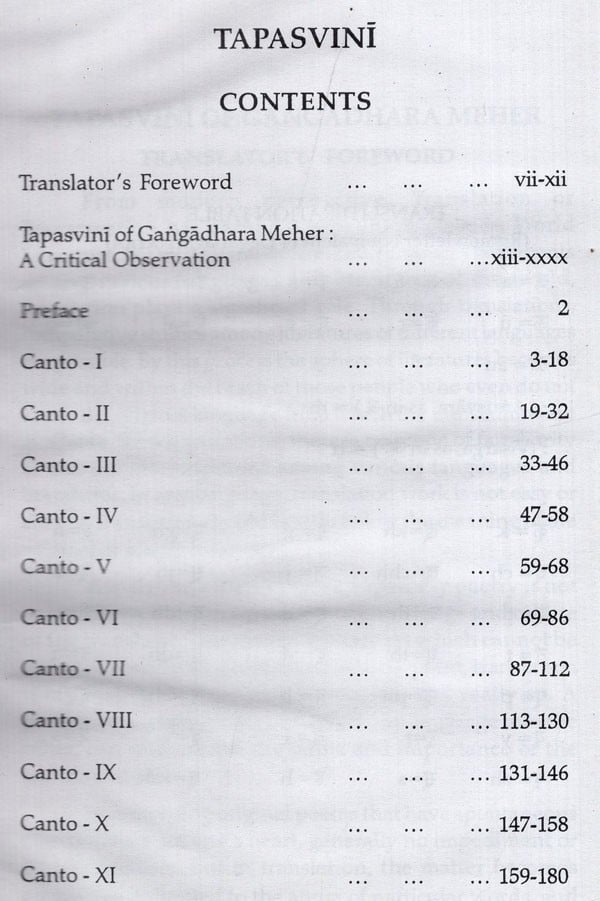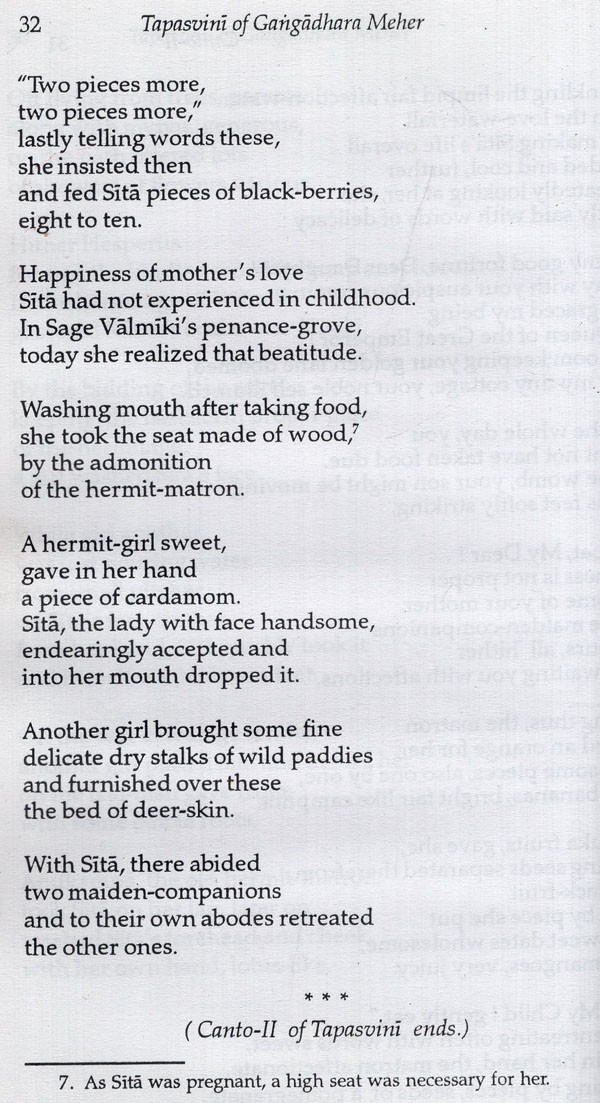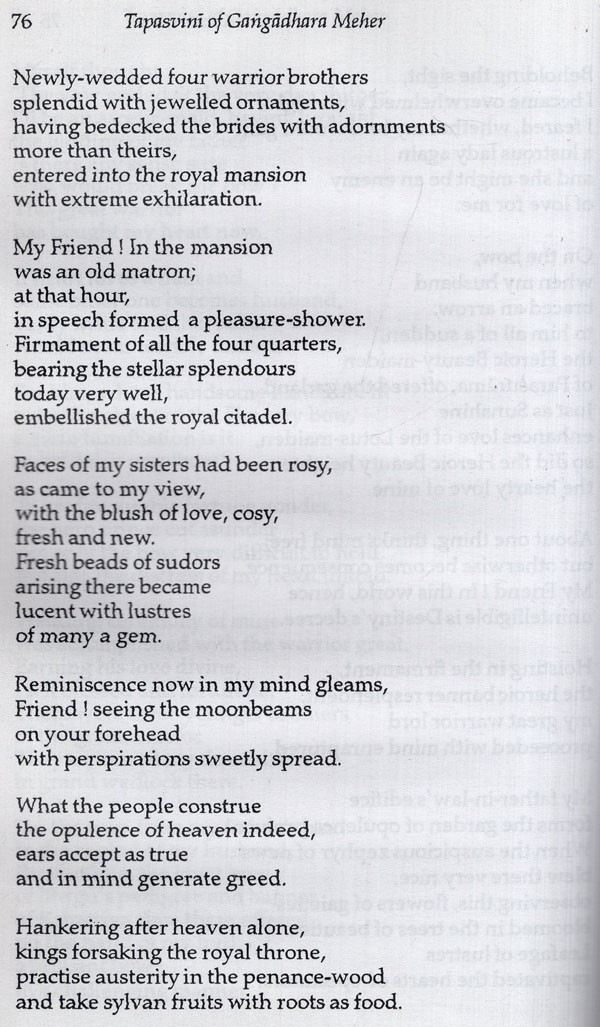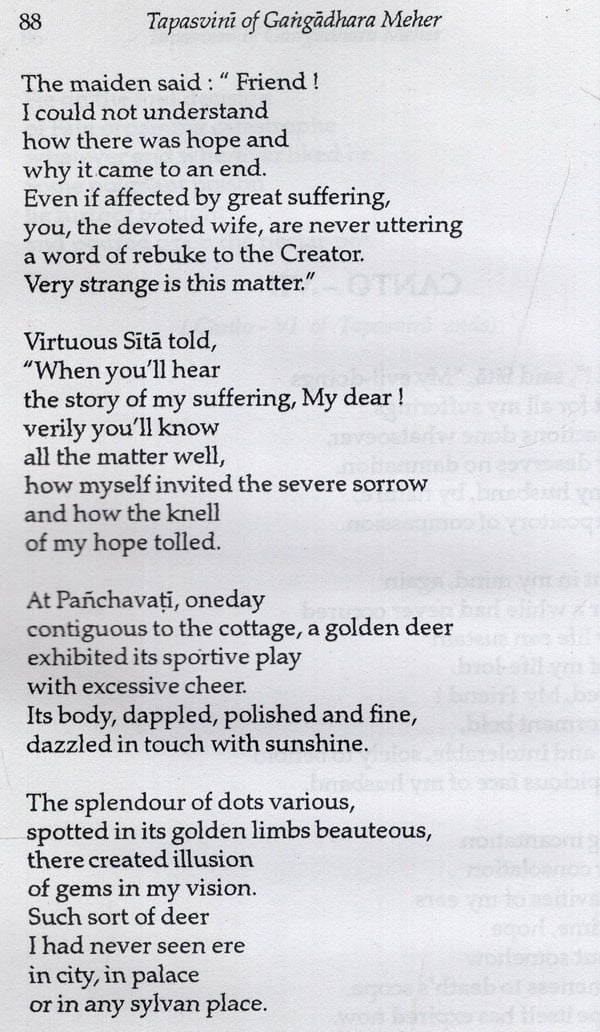
Tapasvini of Gangadhara Meher (An Old and Rare Book)
Book Specification
| Item Code: | UAW563 |
| Author: | Harekrishna Meher |
| Publisher: | R.N. Bhattacharya, Kolkata |
| Language: | English |
| Edition: | 2010 |
| ISBN: | 9788187661634 |
| Pages: | 220 |
| Cover: | HARDCOVER |
| Other Details | 8.50 X 5.50 inch |
| Weight | 350 gm |
Book Description
Svabhava-Kavi Gangadhara Meher Born: 9 August 1862, Sravana Purnima. Died: 4 April 1924, Chaitra Amäväsyä.
Gangadhara Meher, popularly known as 'Svabhava-Kavi' is one of the illustrious makers of Indian literature. Like Kälidäsa in Sanskrit and William Wordsworth in English, Gangadhara Meher is regarded as 'Prakriti-Kavi", Poet of Nature, in Oriya literature.
Tapasvini. an eleven-canto Oriya epic poem, is the magnum opus of this great poet. With the prevailing sentiment of Pathos, this Rāmāyana-based kävya depicts the post-banishment episode of Sita in the hermitage of Sage Välmiki. Here Sità in her later life appears as a Tapasvini'. A lady observing penance or An Ascetic-maid. The poetic presentation is marked with originality and significant innovations. With vivid and prominent delineation of Sita's life. Tapasvini kavya may be construed as a 'Sitayana' in the field of Indian Literature. Poet's Philosophy of Life elucidated in the mouth of River Tamasă is noteworthy: "Wandering over several woods wide, never wavering astray by illusion of any gorge, surmounting many an impediment in my life limpid, never deeming darkness as a distress, never thinking light to be a delight, for a remote way ahead I've continued to forge with my head humbly bent. Gratifying every bank-dweller with offering of water, fruitfulness of my birth I'm realizing worth'. (Tapasvini 4/11)
(English Rendering of Original Oriya Mukhabandha' of Tapasvini Kavya) Of Rama, because of his forest-repairing to keep his father's word true, and of Sita, because of her following the foot-steps of her husband, the greatness that had bloomed became fraught with fragrance on Sita's banishment. By brooking the pangs of exile, as Sita's devotion-to-husband became effulgent, so did Rama's love for his wife shine resplendent on the observance of horse-sacrifice by placing the gold image of Sitä. Befitting wife of befitting husband. Even if deserted by husband owing to the false public calumny, Siti had truly realized the heartiest love of her husband. The main purpose of this book is to elucidate how Sita strengthened and heightened more and more, her devotion-to-husband by deeming exile as her own misfortune and how she as a Tapasvini (Ascetic-maid) spent time by rendering her forest-dwelling into penitential austerity beneficial to her husband.
Sitä had relinquished hope of obtaining mercy of her husband. In the like manner, I have given up hope of being successful in depicting her exalted character. However, Rama had accomplished the sacrifice by making the attractive image of his heart's Moon-beam Sita, in lieu of Sita, the Ascetic-maid. I hope, dear wise readers, without aiming at my success in this shall once unveil the memory's curtain portrayed with the brilliant impeccable and sacred character of Sita of their own hearts, and shall render uplift of the hearts of women at large.
To conclude, I am to say that the vigorous inspirations given by my dear friend Sri Brajamohan Panda in composing this book have no compare in all aspects. For this, I express my deep sense of gratitude to him.
**Contents and Sample Pages**













